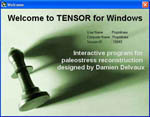
|
| ABOUT |
| CONTACT |
| LINKS |
|
|
|||||||||||
|
|
|
||||||||||
|
|||||||||||
|
How to refer to the Tensor program in publications?
This paper descrives the fault-slip data used, the notion of subsets, the principle of the Right Dihedron and Rotational Optimisation methods and the quality ranking. In addition, one or several of the following references can be also cited. Application of Win-Tensor for large and multiphase data sets, implementation of statistics and standard deviations to the results: Kipata, M.L., Delvaux, D., Sebagenzi, M.N., Cailteux, J.-J., Sintubin M. (2013). Brittle tectonic and stress field evolution in the Pan-African Lufilian arc and its foreland (Katanga, DRC): from orogenic compression to extensional collapse, transpressional inversion and transition to rifting. Geologica Belgica, 16/1-2, 001-017.Application of Tensor program to fault-slip data and definition of the Stress Regime Index R': Delvaux, D., Moeys, R., Stapel, G., Melnikov, A. and Ermikov, V. (1995). Paleostress reconstruction and geodynamics of the Baikal region, Central Asia. Part I. Pre-rift evolution: Paleozoic and Mesozoic. Tectonophysics, 252: 61-101.Use of hybrid factures with Win-Tensor: Delvaux, D. (2012). Release of program Win-Tensor 4.0 for tectonic stress inversion: statistical expression of stress parameters. EGU General Assembly, Vienna, 2012. Geophysical Research Abstracts, Vol. 14, EGU2012-5899.Release of Win-Tensor version 4.0: Delvaux, D. (2012). Release of program Win-Tensor 4.0 for tectonic stress inversion: statistical expression of stress parameters. EGU General Assembly, Vienna, 2012. Geophysical Research Abstracts, Vol. 14, EGU2012-5899.Presentation of Win-Tensor for Windows: Delvaux, D. (2011). Win-Tensor, an interactive computer program for fracture analysis and crustal stress reconstruction. EGU General Assembly, Vienna, 2011. Geophysical Research Abstracts, Vol. 13, EGU2011-4018.First release of Tensor for DOS: DELVAUX, D. (1993). The TENSOR program for paleostress reconstruction: exemples from the east African and the Baikal rift zones. EUG VII Strasbourg, France, 4-8 April 1993. Abstract supplement N°1 to Terra Nova, vol. 5, p. 216. Technical bibliographic references
|
|
Bookmark this site!
|
|||||||||


